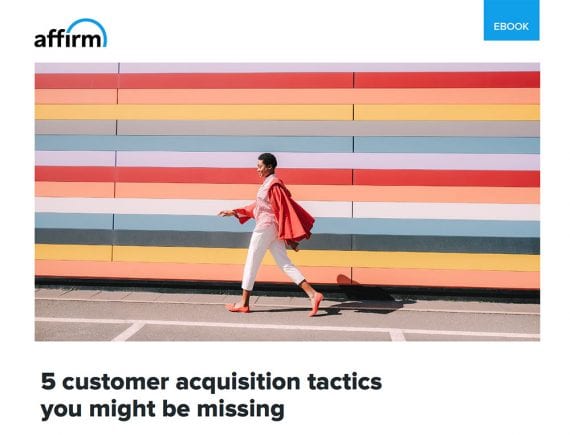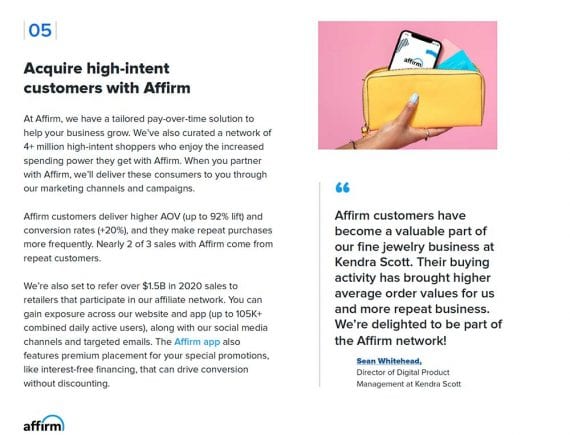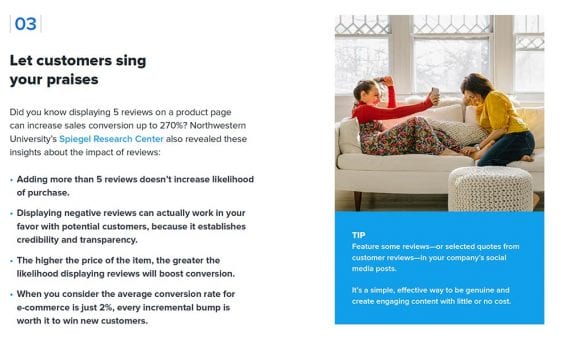Using an Ebook for B2B Lead Generation
Trading an ebook for a prospect’s contact information is among the purest forms of content marketing. It’s an effective way for B2B sellers to find their next customer.
B2B companies supply the products that ecommerce and omnichannel sellers retail to the general public.
I was recently reminded how a simple ebook can be an excellent B2B customer acquisition tool when I downloaded one from Affirm, the installment loan company, in exchange for my LinkedIn profile information and email address.
Here are some of the insights I drew from Affirm’s ebook.

This screen capture is from the cover page of Affirm’s ebook. The bright and colorful image was also featured in the LinkedIn ad.
Using an Ebook for B2B Lead Generation
1. Capture a lead. Affirm’s ebook was presumably developed as a lead capture device. Consider the evidence.
- It was featured in an ad on LinkedIn.
- Its title, “5 customer acquisition tactics you might be missing,†takes advantage of the fear of missing out.
- Lists attract clicks; listicles are sometimes considered link bait.
- The ad was almost certainly aimed at me because of my ecommerce work.
- The fifth tactic in Affirm’s ebook is its own service. It prepares the reader for Affirm’s follow-up.

The final customer acquisition tactic in Affirm’s ebook was the company’s own service. This was also the longest tactic in terms of the word count.
2. Combine with ads. I define content marketing as the act of creating, publishing, and promoting content with the aim of attracting, engaging, and retaining customers.
In practice, marketers often emphasize creating and publishing the content but not promoting it. This is a mistake when your goal is lead capture. So I applaud Affirm’s decision to buy ads around the ebook.
This is not to say that you should be advertising every new blog post. But when you have an ebook for lead capture, why not buy attractive ads around it, with compelling graphics and a click-grabbing title?
3. Your ebook can be short. This Affirm ebook is brief. The PDF is just eight pages, including a title page and an “About Affirm†page. There are fewer than 1,100 words, 107 on the “About Affirm†page. This article is roughly 700 words.
In my mind, Affirm’s ebook was too short. But the point is that you don’t need to create a massive tomb to acquire leads. Your ebook can be short and focused. Provide enough content to make good on the promise in your title and your promotion. That’s all you need.
Ebooks are within your company’s reach.

This single page with a couple of short paragraphs and a list constituted a full section in the Affirm ebook.
4. A little value is still value. Offer something of value when asking a prospective customer for an email address and, by implication, permission to contact. This is reciprocity — trading things of value for the mutual benefit of two parties (your company and your prospect).
The value you offer, however, should be proportional to what you ask in return. My email address is worth something. But it’s not worth, say, an entire encyclopedia set. A bulleted list of reasonable customer acquisition tactics, which is what Affirm offered, seems fair.
Make sure the value you provide is worth it to your prospect.
5. Automation. Although I downloaded the ebook directly from the LinkedIn ad after sharing my email address, I still received an email from Affirm with a link to the ebook and a marketing message.

Automate your lead follow-up with a nurture campaign that helps guide the prospect toward a purchase.
I suspect Affirm initiated a marketing automation workflow when it captured my email address. Likely I will receive a couple more emails in the series.
This is something you should consider for your ebook, too. Develop an automation flow that guides your new prospect toward more engagement. The content opened the door to a new relationship with your company, but you still have to nurture it.
Borrow from Others
Affirm’s marketing team did a pretty good job with the ebook. It captured my contact info and intrigued me enough to compose this article. But it wasn’t perfect. You can do better.
Build on Affirm’s example for your next lead capture campaign.
_________________________________________
This article is written by Armando Roggio and originally published here
